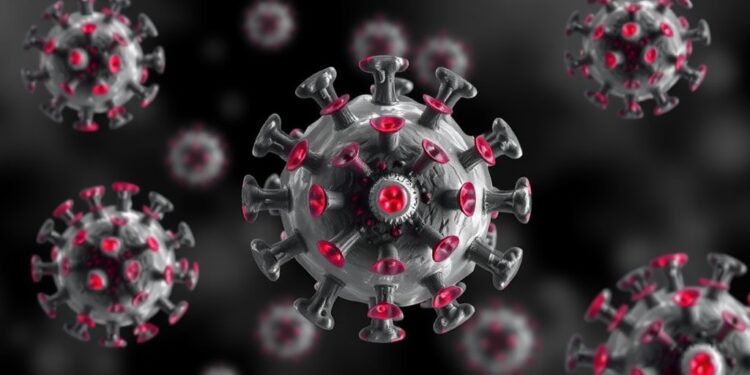In a significant advance in our understanding of respiratory viruses, a groundbreaking study led by the Peter Doherty Institute for Infection and Immunity and the University of Pittsburgh has unveiled a detailed mapping of specific mutations that enhance the transmissibility of SARS-CoV-2. By meticulously analyzing millions of viral genome sequences gathered from diverse global populations, the research team has pinpointed key genetic alterations that provide the virus with a ‘turbo boost’ in its capacity to spread.
The study, anchored by Professor Matthew McKay, a respected figure in viral research, emphasizes the identification of a limited number of mutations—one of which can significantly escalate the virus’s transmission dynamics. Many of these crucial mutations reside within the spike protein, a feature of SARS-CoV-2 that plays a vital role in its ability to infiltrate human cells, thus contributing to its pathogenicity. However, the research expands beyond traditional focus. The findings reveal that critical alterations also occur in lesser-studied regions of the virus, indicating they contribute to the virus’s ability to attach to human cells, evade immune responses, and modify protein structures in ways that enhance virulence.
In an innovative move, the research employs a mathematical framework that is not only simple but also remarkably effective. This model draws from genomic surveillance data, allowing researchers to accurately identify the specific mutations fueling the spread of various viral variants, even when these mutations are present in only a fraction of reported cases. This precision represents a paradigm shift in viral genetics, moving from broad observational studies to focused, mutation-specific analyses.
While the model centers on SARS-CoV-2, the implications of this research extend beyond the COVID-19 pandemic. The versatility of the model suggests that it can be adapted for studying the transmission dynamics of other infectious agents, such as influenza. This adaptability presents a potential for cross-application, making it a valuable tool in the broader scope of public health surveillance and response strategies against emerging infectious diseases.
The researchers describe this methodology as akin to a magnifying glass that enhances our understanding of viral evolution. Associate Professor John Barton from the University of Pittsburgh highlighted this advancement, stating that it offers public health authorities a robust mechanism to detect and monitor rapidly transmissible variants before they establish a foothold in the population, potentially averting widespread outbreaks.
As public health systems grapple with the ongoing challenges presented by the COVID-19 pandemic, the ability to track the emergence of new variants is critical. The study underscores the urgency of acting swiftly and decisively in response to genetic changes in SARS-CoV-2 and other pathogens. By employing this method, researchers can contribute to global health initiatives aimed at controlling infectious diseases more effectively.
Moreover, the study has garnered support from prestigious institutions such as the National Institutes of Health in the United States, underscoring its credibility and significance. The research also involved collaboration with multiple universities, emphasizing a global effort to tackle one of the most persistent challenges faced by modern medicine.
The findings bring to light the intricacies of viral transmission and mutation, raising essential questions about vaccine efficacy, public health policy, and genomic surveillance. As this research unfolds, it may lead to critical advancements in our ability to predict and respond to future outbreaks. By continuously monitoring genetic changes in viruses, scientists are better equipped to inform vaccine development and deployment strategies in real-time.
A robust understanding of viral evolution is paramount in adapting our methodologies to protect global health. The insights gained from this study reflect a critical intersection of computational modeling and virology, positioning researchers to tackle emerging threats with greater confidence and precision. The team envisions that the methodologies developed from this work could form the basis for more expansive studies into the evolution and transmission of various viral pathogens.
As researchers continue to integrate computational techniques with genomic data, the potential for understanding and controlling infections will significantly expand. The development of a rapid response toolkit that includes the ability to assess and counteract viral mutations may prove invaluable as societies aim to move forward in the wake of global pandemics.
At its core, this study demonstrates that our understanding of transmissible diseases hinges on the ability to decipher genetic landscapes. By mapping mutations and their impacts on viral dynamics, researchers not only enrich the scientific community’s knowledge but also fortify global public health infrastructures against future threats.
In conclusion, the implications of this pioneering study echo far beyond the immediate findings. It establishes a pathway toward more responsive and informed public health interventions that could transform our approach to managing viral pandemics now and in the future.
Subject of Research: Viral genome mutations and SARS-CoV-2 transmission
Article Title: Inferring effects of mutations on SARS-CoV-2 transmission from genomic surveillance data
News Publication Date: 7-Jan-2025
Web References: Nature Communications
References: Lee B, et al. Inferring effects of mutations on SARS-CoV-2 transmission from genomic surveillance data. Nature Communications (2024).
Image Credits: N/A
Keywords: SARS-CoV-2, mutations, viral transmission, genomic surveillance, public health, computational modeling, vaccine efficacy, pandemic response.
Tags: enhancing virus transmission dynamicsglobal viral population studiesimmune evasion mechanisms of SARS-CoV-2mathematical modeling in virologypathogenicity of respiratory virusesPeter Doherty Institute for Infection and ImmunityProfessor Matthew McKay viral research.respiratory virus research breakthroughsSARS-CoV-2 variant identificationspike protein mutations in virusestransmissibility mutations in SARS-CoV-2viral genome sequence analysis





